Back To The Future Day: October 21st, 2015
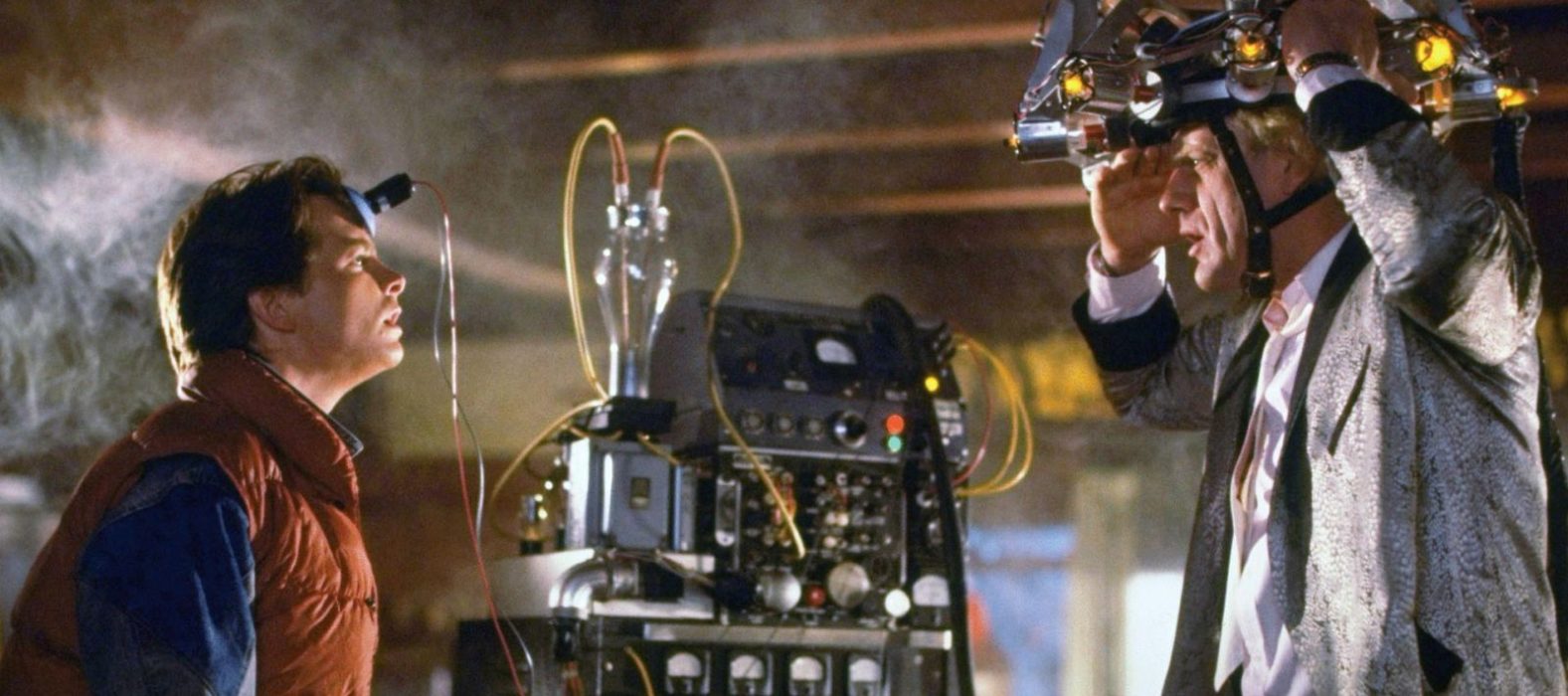
Sam is 25 years old from the West Midlands region…
There are franchises that have their special days to commemorate their enduring legacy, usually ones which are directly implied from the films. Star Wars, for example, has its May 4th as a reference to the famous “may the Force be with you” quote, and the Back To The Future trilogy also has its own. As the series centres on time travel and that there are a number of dates which our heroes transport to, the one that arguably stands out as ‘Back To The Future Day’ is October 21st, 2015.
Our heroes ventured to that date in Part II (1989) and with that date fast approaching, coincidentally being the franchise’s 30th anniversary too, this article is a celebration of the trilogy’s success. I will be going back in time, so to speak, to reflect on the most significant features and will raise the question – what aspect of the Back To The Future trilogy stands out as the most prominent feature among popular culture?
Narrative structure
As the general titles of the trilogy indicate, the clear plot style is time travel by mainly transporting to the past to return back to the future (pun intended). We, the audience, are whisked into various time zones from historical dates such as September 1885 as seen in Part III, to present dates of 1985 when the films were produced and to futuristic dates like October 21, 2015 in Part II, which is quite literally today.
By following joint protagonists Martin “Marty” McFly (Michael J. Fox) and Dr. Emmett “Doc” Brown (Christopher Lloyd) into these different stages of time throughout the series, it relies on viewers’ imagination. Sadly, we don’t have any time travelling devices nor any flying vehicles in October 2015 as Part II portrayed. But throughout 1985-1990, the films allowed audiences to picture in their minds what it would be like if we could witness what has been (the past) and what will be (the future), right before our eyes.
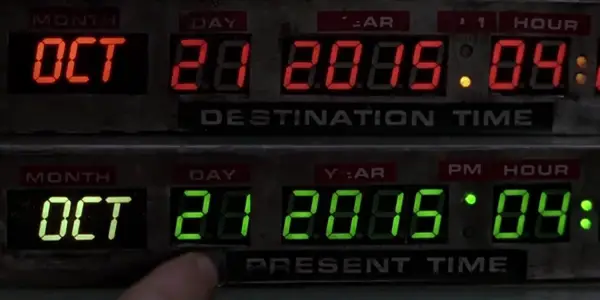
Despite the trilogy going back into different time stages, each film still follows a linear narrative structure. They still have a beginning, middle and end, but the events in different years are part of the plots. In other words, the series has an abundance of flashbacks and flashforward sequences. Marty has a goal to complete and the time travel is a narrative device to fulfill that. Marty returns to 1985 and the story is resolved, and yet, other unfinished business is entwined that builds up to the next instalment.
It may be fair to argue that the narrative structure of the Back To The Future trilogy is the most unique, but also the most accurate in terms of how Hollywood traditionally depict storytelling into forms of excitement for the audience. That is what Back To The Future did best in terms of narrative: following a structure of classical Hollywood film, but for a contemporary audience (at the time). Back To The Future may be the most popular representation of time travel in cinema, but even now, after 30 years since Part I’s release, the narrative structure of the trilogy is still discussed today.
Characters and star performance
Could the standout feature of Back To The Future be our heroes and villains, or the star performances? In many ways, the combined characters are a representation of 1980s America through clothing, music and the general fact that the film’s present time is 1985 – when Part I was released. From the franchise’s opening scenes, viewers follow Marty on his adventures and in some respects, become him. In the first film, he is inadvertently deported to 1955 when he meets his parents at a younger age. Marty’s encounter with his family plays on audience thoughts to imagine how their elder relatives lived, except we don’t want our mothers to have romantic interests in us, do we?
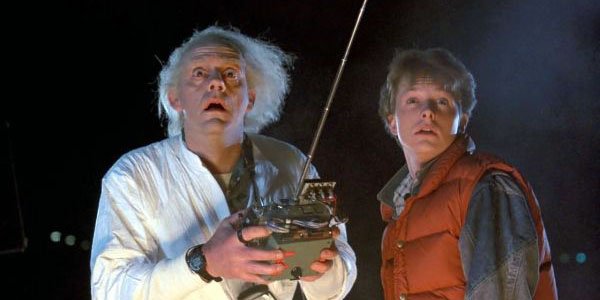
Needless to say, Back To The Future was released in an era when cinema’s main emphasis were centred on youth and by following Marty into different stages of time throughout the trilogy, his adventures allow a stronger appeal for younger audience.
There are other arguments, however, that suggest some characters from the trilogy are recycled from past others. For example, the western settings could be recreation of John Wayne features, much like Doc as a whole could be an exaggerated representation of Isaac Newton, Thomas Edison and Albert Einstein.
Doc builds the unique time travelling device from a DeLorean sports car that changes the whole course of the future (one that usually works by lightning), but does not consider all the consequences. Doc has an eccentric mindset, one that is represented positively throughout the films, but his friendship with Marty and his unique inventions are significant in audience’s involvement and for revolutionising cinema’s technological advancements.
Props and technology
As the trilogy’s main plot concept is on time travel, its use of technology and key props were absolutely crucial in leaving its mark on popular culture. In the first film’s opening credits, for example, we see a lengthy panning shot of numerous clocks with the only sounds heard being the ticking. Clocks are key objects associated with time and they appear regularly throughout the trilogy, including on digital formats within the time travelling machine as seen when venturing to 12th September 1885, 12th November 1955, 26th October 1985 and 21st October 2015.
The films’ newspaper The Hill Valley Telegraph and McFly family photographs are other crucial props that are significant in translating the past into the present and future. This is because both source materials elicit a viewpoint of particularly the past and they are symbolic in changing the future. The newspaper, in particular, is used a narrative device to help Marty and Doc resolve dilemmas concerning potential events changing. They provide factual information but are also used as tools for Marty and Doc to alter what was, what is and what could be. In fact, the faded headlines and reinstated details are significant as the contents become the result of Marty and Doc’s actions.

Similarly, other props used in the series are renowned objects that revolutionised technological advancements in Hollywood, but also marketing sales among the film industry. For example, the Hover Board’s seen in Part II are about the coolest inventions from the trilogy and the action scene is about the most exciting. That is what makes the technology and props in Back To The Future so timeless – they are part of the action and, therefore, the audience’s enjoyment. Due to this, society is able to purchase merchandise from the series to enhance fandom and continue the franchise’s popularity. And, of course, who could forget the DeLorean sports car used as the time machine?
Obviously, the machine is the central source to Marty and Doc’s transportation throughout Back To The Future. Consequently, the DeLorean is a significant component from within the trilogy. It was only on the American market from 1981-1983 and the Back To The Future franchise restored its popularity. In fact, a DeLorean currently stands as a display at Universal Studios and a student-made DeLorean will be unveiled to commemorate Back To The Future Day on 21st October 2015.
The technology unveiled since Part I may have been an indication of what the future may hold for us. There may have been technological predictions for 2015 following Part II in 1989 and some have been accurate. These include the Hover Board, video calls, hands-free gaming and tablet computers while others, like the flying car and the time machine (or a teleporting machine), have yet to appear. Let’s make predictions – 2115? We’ll see.
Use of music
As opposed to narrative, characters and technology, Back To The Future’s use of music is perhaps the most overlooked element that has made it a timeless franchise after thirty years. The franchise is known for Alan Silvestri’s score (which does resemble that of John Williams) and its soundtrack release, but importantly, the franchise features music sequences from different stages of American history.
In 1985, Marty is in a guitarist band called ‘The Pinheads’ who played a hard-rock version of “The Power of Love” by Huey Lewis and the News. This was a track recorded specifically for the film. As previously stated, the films’ strong emphasis is on youth and witnessing Marty and bandmates play the guitars and seeing him skate home with earphones plugged in already suggests a touch upon younger viewers.
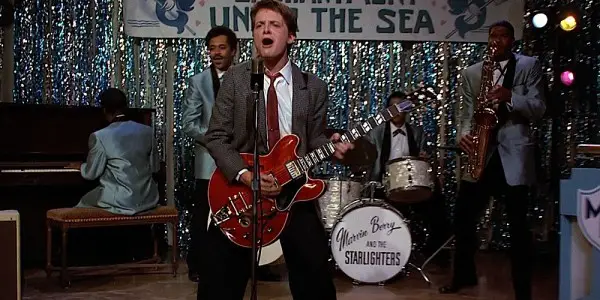
When Marty travelled to 1955, he performed “Johnny B. Goode” by Chuck Perry, which was actually released originally in March 1958 – three years after the first film’s past setting. Similar to its use of technology, the franchise introduces the concept of intertextuality (the deliberate inclusion of one text within another and their identical meanings) and encourages using music as a narrative device and as a marketing ploy. Clearly, music has been an influence to the trilogy as an upcoming musical is scheduled to hit London’s West End this year in honour of the franchise’s 30th anniversary.
Its media legacy
In the aftermath of the finale’s release in 1990, Back To The Future was adapted to other forms of media. Immediately after Part III, a simulator ride opened as part of the series which was simply known as Back To The Future: The Ride. It originally opened at Universal Studios Florida in 1993, three years after Part III‘s release, but has since relocated to Japan’s Universal Studios. Some even considered it a mini-sequel to the trilogy, but are the producers looking to the future with a fourth instalment?
According to a CinemaBlend article, its co-creator and producer Bob Gale has finalised that there will not be. He says “Let’s face it, we’ve seen a lot of sequels that are made years and years later and I don’t think I can name one that’s any good, that lives up to the originals. I don’t think you can recapture it.” As Hollywood is now dominated by sequels and remakes, leaving this beloved franchise at its prime may have been the right decision, and Gale and Zemeckis deserve respect for it.
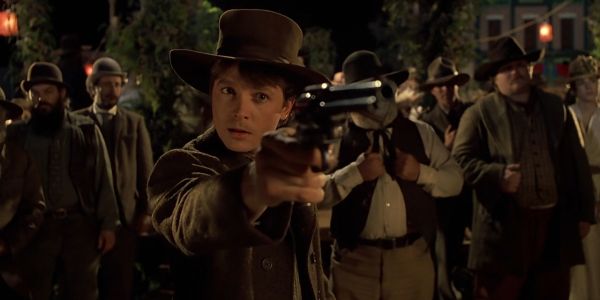
With no more feature films in the trilogy, its legacy continued with an animated television series from 1991 to 1992, which allowed more space for further adventures. The show saw Christopher Lloyd reprise his role of Doc as it followed his adventures within a new time machine after the DeLorean was destroyed, and continued the story after the events of Part III.
The series lasted just with twenty-six episodes in two seasons, but it was well-received by critics and the franchise became even more popular. There was the release of comic books which continued the adventures from the animated series, though they were without the involvement of co-creators Robert Zemeckis and Bob Gale, nor stars Michael J. Fox and Christopher Lloyd. Furthermore, several console and video games were released.
As I’ve already pointed out, a musical based on the original film trilogy will probably begin in 2015 and even now, after thirty years, Back To The Future has still maintained its timeless and influential legacy across the globe.
Conclusion
Robert Zemeckis’ and Bob Gale’s Back To The Future trilogy was once listed among the greatest family franchises and the most influential among popular culture. In total, the series earned a combined six Academy Award nominations, some of which were for Best Original Screenplay and Best Original Song for “The Power Of Love”, but from an industry viewpoint – do films really need to be awarded or nominated for Oscars to be successful? Not necessarily.
Back To The Future had all its uprising stars, crafty director Robert Zemeckis, his co-writer and co-creator Bob Gale and executive producer Steven Spielberg at the helm to maintain the franchise’s timeless status after thirty years among the science-fiction genre and its filmic contributions to Hollywood.
Will there ever be a fourth instalment in the trilogy? Do you think Michael J. Fox and Christopher Lloyd should return for another adventure as our favourite time travellers Marty and Doc? Or should they leave the beloved trilogy where it is?
Are you interested in the forthcoming musical based on the trilogy?
Which is your favourite Back To The Future instalment? Do you have a favourite scene? If so, comment below to let me know.
(top image source: Universal Pictures)
Does content like this matter to you?
Become a Member and support film journalism. Unlock access to all of Film Inquiry`s great articles. Join a community of like-minded readers who are passionate about cinema - get access to our private members Network, give back to independent filmmakers, and more.
Sam is 25 years old from the West Midlands region of the UK, who has a passion for the world of cinema and publishing. He is currently studying a postgraduate degree in Film & Television: Research and Production at the University of Birmingham. He is currently working in theatre and academic support.













